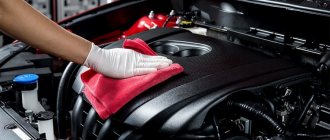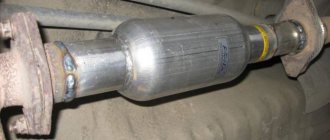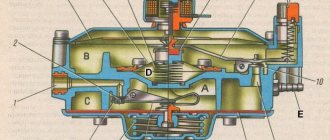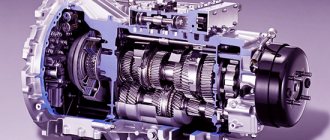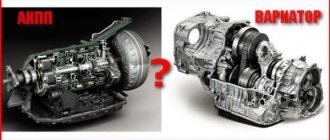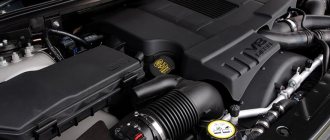Signs of a clogged catalyst
One of the main symptoms of a malfunction is a decrease in engine power and a noticeable deterioration in vehicle dynamics. This is manifested by a noticeable decrease in maximum speed and sluggish acceleration when starting from a stop at a traffic light or when overtaking. There are other signs indicating problems with the catalyst:
- Difficulty starting both cold and hot engines.
- If the unit is severely clogged, a complete failure of the power unit is possible.
- An unpleasant smell of hydrogen sulfide (rotten egg) appears in the exhaust.
- Engine speed spontaneously decreases or increases.
A malfunction of the catalyst may be accompanied by the Check Engine light on the instrument panel.
The control lamp turns on when the active substance is suddenly destroyed or the wires transmitting the signal from one of the two sensors are damaged. They are installed in front of the inlet and after the outlet pipe of the unit and control the content of active oxygen. With gradual clogging, the indicator does not indicate system failure.
Rice. 2 – “Contamination and destruction of the catalyst filler”
Why does the catalytic converter fail?
The resource of this unit is quite large - for the first 120-150 thousand kilometers the driver may not even be aware of the existence of the catalyst. Problems begin when the “Check engine” error lights up on the instrument panel. This error appears when the “cells” of the device burn out and it is impossible to further filter gases. When burned out, the cells decrease in size, lose their ability to glow from the heat coming out of the cylinders, and therefore become useless in the fight against pollution.
In addition to long-term operation, another reason for the failure of the catalytic converter is low-quality fuel. As a rule, its octane number is artificially increased by diluting it with special additives. They contain one of the heavy metals – lead. Its entry into the filter elements leads to a critical increase in the temperature inside the honeycombs and their melting. Thus, the honeycombs begin to become contaminated with their own deposits, which causes a drop in the efficiency of catalytic cleaning. There is only one way out - to change the broken unit.
Causes of a clogged catalyst
The full name of the mentioned unit is a catalytic exhaust gas converter, which is a complex structure. The stainless steel housing contains a ceramic or metal carrier with many longitudinal pores of small diameter called honeycombs. It is installed directly behind the exhaust manifold in front of the cutter, muffler and exhaust pipe.
With long periods of operation, carbon deposits form in the pores or they become clogged with solid particles, the reasons for this are:
- Long-term use of low-quality gasoline or diesel fuel, which does not completely burn in the cylinders and forms a large amount of soot. Afterburning of fuel vapor occurs inside the carrier, which leads to its overheating and deformation.
- The use of leaded gasoline is especially unacceptable; tetraethyl lead will damage the catalyst in a short time.
- Large oil waste due to wear of the piston oil rings or valve stem seals.
- Mechanical destruction of the filler is a consequence of impacts on the unit body due to road unevenness.
Rice. 3 – “The principle of operation of the exhaust gas converter”
With rare exceptions, clogging of this device occurs as a result of prolonged use of a faulty motor. Therefore, when the first signs appear, it is necessary to check whether the catalyst is clogged or not using one of the methods suggested below. In the early stages, it is easier to eliminate engine defects and restore the functioning of the unit.
Drilling out the catalyst
The simplest and most effective way to solve the problem with the catalyst is to drill a through hole in its honeycomb structure. As a result, exhaust gases exit directly from the muffler, there is no back pressure, which increases power, eliminating the need to replace this expensive element.
You just need to remember that such work presents a certain complexity; it will be impossible to drill a hole in the ceramic honeycomb of such an exhaust gas neutralizer yourself. Therefore, you will need to contact specialized workshops. Such work is performed using special equipment and has an appropriate cost.
The undoubted advantage of drilling out the catalyst is that there is no subsequent need to install a flame arrester, which significantly complicates the entire design of the exhaust system. Immediately after making the appropriate holes in the catalyst, fuel consumption decreases and engine power increases by 5-7%.
You can only trust drilling of the catalyst to professionals, since if you do this work incorrectly, you can ruin the entire exhaust system, and dust particles will be sucked into the cylinders. Subsequently, eliminating scuffs and replacing the cylinder block will cost car owners a significant amount.
If we talk about the disadvantages of such work, we note an increase in oil consumption, which is associated with a change in back pressure in the system. The engine in a car is initially designed to operate at a certain back pressure and changing it can lead to an increase in oil pressure. Such problems can be solved by using thicker and more viscous oil in the car.
How to check if the catalyst is clogged?
Diagnostics of the exhaust system can be carried out by the driver himself or by car service specialists. The most reliable way to both check the catalyst and eliminate its malfunction is to dismantle and inspect the unit. However, this method is the most complex and time-consuming: the fastening bolts stick, and the threaded connections cannot always be unscrewed.
Rice. 4 – “Visual check of the catalyst”
If, during the inspection process, powder spills out of the catalyst removed from the car, this indicates its destruction. This unit definitely needs to be replaced. If things have not gone to extremes, you can verify that the honeycomb is clogged by shining a flashlight into one of the nozzles. If you do not see light on the other side, then most of the pores are impenetrable to the light beam and exhaust gases.
Rice. 5 – “Checking the catalyst with a pressure gauge”
There are other less labor-intensive methods for checking the catalytic converter, which are used by service stations and drivers:
- We try to close the exhaust pipe with a gloved hand while the engine should be running at idle speed. If the exhaust system is working properly, this will not be possible; you will clearly feel shocks in your hand.
- Measure the pressure in the exhaust manifold using a pressure gauge connected to the fitting instead of the residual oxygen sensor (lambda probe) at the inlet of the catalyst. If this indicator exceeds 0.3 kgf/cm2 at an engine speed of 2500 min-1, then the unit is faulty.
- You can accurately determine a clogged catalyst using a motor tester. In place of one of the spark plugs, a special pressure sensor is installed, the readings of which are displayed on an oscilloscope. The specialist can only evaluate the operation of the engine at high speeds. Pressure in the exhaust system of more than 2 kgf/cm2 directly indicates that the filler is obstructed.
The choice of method for checking the catalytic converter is at the discretion of the car owner. It should be noted that the most reliable methods are dismantling and visual inspection of the unit and diagnostics using a motor tester.
Rice. 6 – “Checking the catalyst with an oscilloscope of a motor tester”
What does the catalyst affect and what is its resource?
The chemical composition of exhaust gases from modern cars includes a wide range of toxic elements. To protect the atmosphere from harmful substances, catalytic converters (CNs) were developed, but most often they are simply called “catalysts.”
The devices are installed in cars running on both gasoline and diesel engines. The purpose of the device follows from the principles of its operation. We will also talk about the consequences that occur when removing the catalyst from the vehicle.
Catalytic converter device
Without a working catalyst, it is impossible to imagine the correct operation of the exhaust system of a modern vehicle. It contains a neutralizer, which consists of the following elements:
- metal housings, including pipes for the entry and exit of toxic substances;
- monolithic ceramic block with a cellular texture;
- a special “gasket” for the transformation of harmful substances, which is a coating with a cellular texture;
- metal protective casing.
The construction of a car catalyst involves the use of precious metals for the design. In some models they are replaced with gold inclusions, which has reduced production costs.
The catalyst device is aimed at neutralizing nitrogen oxides, carbon monoxide and hydrocarbons. Thanks to this, the devices began to be called three-component. Nitrogen oxides are a component of smog and cause acid rain (harmful to humans). If there is a high concentration of carbon monoxide in the air, it can harm people around. As for hydrocarbons, they also have a harmful effect on the human body when the permissible concentration is exceeded.
Operating principle of the catalyst
If we analyze in detail the principle of operation of catalysts, we can distinguish several stages in order:
- Toxic substances enter ceramic blocks, which are distributed among the cells until completely filled.
- Precious metals react with hydrocarbons, converting them into steam. Oxidation also affects carbon monoxide, turning it into carbon dioxide. Rhodium serves to convert nitric oxide.
- The output is fairly safe chemical compounds.
Is it possible to drive with a clogged catalyst?
The consequences of operating a car with a seriously defective exhaust system can be quite severe. It must be recalled that when the catalyst fails, the following is observed:
- Increased content of harmful substances in exhaust gases.
- There is a significant drop in engine power.
- Due to an increase in exhaust tract resistance, fuel consumption increases significantly, which entails an increase in operating costs.
- When using a car for a long time with a clogged catalyst, at some point the engine simply will not start or, worse, stall while driving.
The greatest damage is caused to the engine in the event of destruction of the catalyst filler. The resulting solid particles can get into the cylinder between its inner surface and the moving part - the piston. As a result, scratches form on the mirror, which can only be eliminated during a major overhaul by grinding followed by honing.
Removing the catalyst, is it bad for the car?
If there is no catalyst in the muffler, then the car will not be worse; on the contrary, the car’s performance will only improve.
If there is a problem with the catalyst, for example, it is clogged or melted, then on many cars the CHECK ENGINE light begins to light up. The car starts to work in emergency mode: traction is lost, the engine is rough and may not even start. If the catalyst is clogged, then the exhaust gases pass through the muffler worse, return back to the combustion chamber and the engine chokes itself.
If the catalyst is not clogged or melted, but CHECK ENGINE still lights up, then most likely this is due to the fact that the catalyst has worn out due to high mileage.
Most modern cars are equipped with oxygen sensors (lambda umbrellas), which are installed before and after the catalyst. These sensors determine whether harmful compounds remain in the exhaust gases at the outlet.
You may also be interested in: Replacing a car windshield yourself
If there are more harmful compounds than normal, then the second lambda umbrella gives a signal that the catalyst is not doing its job and it’s time to change it.
By removing the catalyst, the vehicle's exhaust tract is freed from unnecessary obstruction and exhaust gases come out better. But they are simply more toxic, but the absence of a catalyst does not affect the engine life in any way.
In order for a car to drive normally without a catalyst, you will have to reflash the ECU to a lower environmental class, for example Euro-2. Or, if you don’t want to reflash the control unit, you can install a trick so that CHECK ENGINE does not appear and interfere with normal driving.
What to do if the catalyst is clogged?
As is clear from the above, ignoring a malfunction is fraught with big troubles. A reasonable question arises, what to do if the catalyst is clogged and this has been established absolutely accurately. There are several possible ways out of this situation:
- Try to clean the filler from carbon deposits and solid particles. There are different methods, the description of which is beyond the scope of this article. Another question is that their effectiveness is highly questionable. They are applicable only at the very initial stage of the process, when there are still no signs of clogging of the unit, and no one thinks about a possible malfunction.
- Removing filler from the body and installing a flame arrester and emulators instead of residual oxygen sensors. In this case, you will always forget about the malfunction of the catalyst, but this interference in the design of the exhaust system is easily detected using a gas analyzer, and you will face a fine for environmental pollution.
- Replacing the catalytic converter with a new one. This is the most expensive option - purchasing and installing the unit will cost from 9 to 17 thousand rubles, depending on the make of the car.
There are so-called sports catalysts, which, according to reviews from experts and car owners, provide a power increase of up to 10%. The active elements used as filler make it easy to meet the stringent requirements of current Euro-4 and even Euro-5 standards.
Rice. 7 – “Replacing the catalytic converter on a car”
